SPATIUM-I (Space Precision Atomic-clock TIming Utility Mission I)
EO
Atmosphere
Mission complete
Space environment
SPATIUM-I (Space Precision Atomic-clock TIming Utility Mission I) was a 2U Cubesat developed jointly by Nanyang Technological University (NTU) in Singapore and Kyushu Institute of Technology (Kyutech) in Japan. 6)
The satellite’s main objective was to validate the clocking performance of a commercial off-the-shelf chip-scale atomic clock and demonstrate other key enabling technologies in orbit. 1)
Quick facts
Overview
| Mission type | EO |
| Agency | NTU |
| Mission status | Mission complete |
| Launch date | 23 Sep 2018 |
| End of life date | 23 Sep 2021 |
| Measurement domain | Atmosphere |
| Instrument type | Space environment, Atmospheric chemistry, Data collection |
| CEOS EO Handbook | See SPATIUM-I (Space Precision Atomic-clock TIming Utility Mission I) summary |
SPATIUM-I (Space Precision Atomic-clock TIming Utility Mission I)
Spacecraft Launch Mission Status Sensor Complement References
SPATIUM-I was a CubeSat pathfinder mission developed jointly by NTU (Nanyang Technological University) of Singapore and Kyutech (Kyushu Institute of Technology), Fukuoka, Japan. The primary scientific objective of the SPATIUM program was to develop a reliable platform that derived the three-dimensional global ionosphere plasma distribution with excellent spatial and temporal resolutions. In the program, key enabling technologies were developed and demonstrated. 1)
The main objective was to model the ionosphere TEC (Total Electron Content) based on multipoint measurements of phase-shift in satellite clock signal from a constellation of CubeSats carrying a high precision timing reference. It was known that the satellite signals that transmitted through the ionosphere interacted with ionospheric plasma which caused a propagation delay in the signal transmission. The induced phase delay was inversely proportional to the square of radio frequency. In addition, the radio signal was affected by the atmosphere and another phase delay was expected. Hence, ultra-high frequency (UHF) was selected for SPATIUM mission.
The resolution was expected to be improved by one order of magnitude compared to the case which L-band GNSS signal was used. The signal was spread-spectrum (SS) modulated so that the single frequency could be shared simultaneously by multiple satellites. By measuring the phase difference in satellite signals between two satellites, or between satellite and ground station, the integral of the electron density distribution along the path length could be modelled using custom-designed computational modelling tools. In addition, the analysis was further reinforced with in-situ measurement of plasma density using a DLP (Double Langmuir Probe) onboard each satellite.
SPATIUM-I was the first effort in this program to validate a few key enabling technologies in orbit for a future mission:
• In-orbit demonstration of a COTS (Commercial Off-The-Shelf) CASC (Chip-Scale Atomic Clock) as reliable reference clock of a CubeSat mission;
• In-orbit demonstration of transmission of SS (Spread Spectrum) modulated 467 MHz signal with CSAC as a clock source;
• In-orbit demonstration of transmission and receive of 400 MHz signal as the second UHF band;
• Demodulation of SS Signal at ground station;
• Time-synchronization of multiple ground stations;
• Reading the carrier wave phases (400 MHz and 467 MHz) of the SPATIUM-I satellite.
The success of SPATIUM-I and the developed capabilities could provide a strong fundament for future missions.
Spacecraft
The SPATIUM-I satellite adopted the generic 2U CubeSat design with a dimension of 20 cm x 10 cm x 10 cm with a mass of 2.66 kg. The dimension and mass of the satellite had to strictly adhere to the requirements of the JEM (Japanese Experiment Module) J-SSOD (Small Satellite Orbital Deployer). The satellite structure and configuration of the SPATIUM-I CubeSat is illustrated in Figure 1. The CubeSat structure was designed based on the Kyutech's BIRDS project satellite's bus system. 2) It contained the EPS (Electric Power Subsystem),the battery module, the communication board (COM), the CSAC main mission board, the supercapacitor board and the FAB (Front Access Board).
The satellite used a "harness-free" approach, whose BPB (BackPlane Board) was designed to electrically connect all subsystems together. In order to reduce risk and system complication, the EPS, COM, battery module, FAB and BPB extensively utilized existing designs that were flight proven aboard the BIRDS satellite. Modifications were made to incorporate the CSAC mission board and supercapacitor board in the design. A pair of deployable UHF monopole antennas were used for data transmission at two different UHF frequencies, i.e. 401 MHz and 467 MHz. The monopole antennas were restrained using a nylon fishing string tied around a burning element.
The SPATIUM-I CubeSat is designed to be deployed from the ISS using the J-SSOD for deployment. The CubeSat was powered off while inside the J-SSOD using the RBF (Remove-Before-Flight) pin and the deployment switch located at the base of the J-SSOD. After being released from the ISS, the EPS started working and supplying voltage to turn on the CSAC mission board and supercapacitor board. The CSAC warmed-up for around 2 to 3 minutes and started sending a stable clock signal to the other subsystems. Due to transmission restrictions near the ISS, no satellite communication was made in the first 30 minutes after the satellite was released from the ISS.
After 30 minutes, the burner circuit was activated to deploy the monopole antennas. Since uplink and beaconing was not possible until the antennas were deployed, the burning circuit was activated multiple times to ensure successful deployment. After the antenna deployments, the COM was turned on and data transmission at nominal operation mode started, which is 467 MHz transmission with 20% duty cycle. The operational modes with different frequencies and duty cycles could be changed using uplink command when necessary.
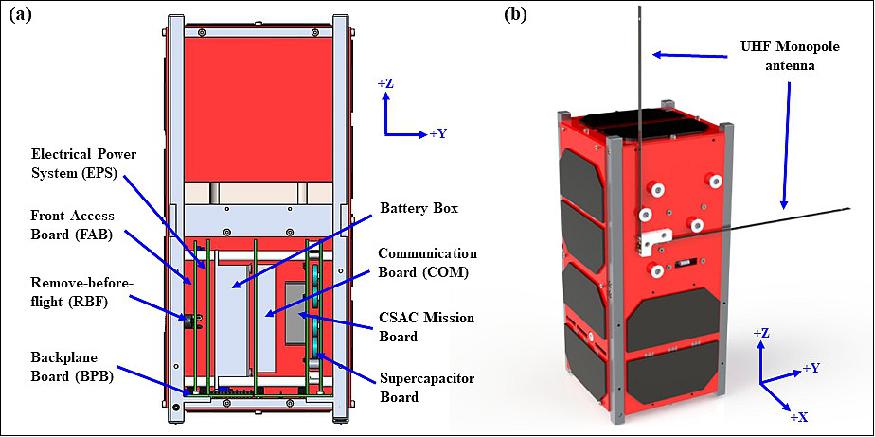
The EPS was responsible for the electrical power management for the satellite including generation, storage, regulation and distribution of electrical power. It was comprised of solar panels, battery module and a custom-designed power management board. The main requirement of the EPS was to effectively distribute power supply to support the CubeSat operations while maintaining a healthy power storage. As shown in Figure 1, all six external panels were covered with total 18 pieces of solar panels, except half of the +X panel was used for mounting of monopole antennas. The average power generation is 2.3 W according to STK simulation. The generated power was supplied to all subsystems for CubeSat operations. Extra energy was stored in a 2000 mAh nickel-metal hydride battery module, which was later used to support the CubeSat operation during eclipse periods. A temperature sensor was attached inside the battery box to monitor the battery temperature, given the fact that the batteries had the most stringent temperature constraint aboard the entire CubeSat.
The communication for the SPATIUM-I CubeSat was based on UHF transmissions for uplink of command and downlink of housekeeping data and clock data. As discussed earlier, SPATIUM-I used both 401 MHz and 467 MHz frequencies for data downlink, and 401 MHz for uplink. The COM board was custom-designed to perform SS modulation for the 467 MHz clock signal. With SS modulation of the satellite signal, the single frequency could be shared simultaneously by multiple satellites. Hence, the SS modulation and demodulation of the satellite signal were the key enabling technologies for the future next phase of the mission, SPATIUM-II, consisting of a constellation of deployed CubeSats. On the other hand, widely used phase modulation (PM) was used for the 401 MHz housekeeping data. The satellite signals were captured and demodulated at multiple ground stations which had the synchronized reference CSAC and GPS clocks.
SPATIUM-I CubeSat flight model (FM) was fabricated and assembled in May 2018 as shown in Figure 2. The satellite passed the JAXA (Japan Aerospace Exploration Agency) safety review and fulfilled all the safety requirements for release from the ISS using the JEMRMS (Japanese Experiment Module Remote Manipulator System).
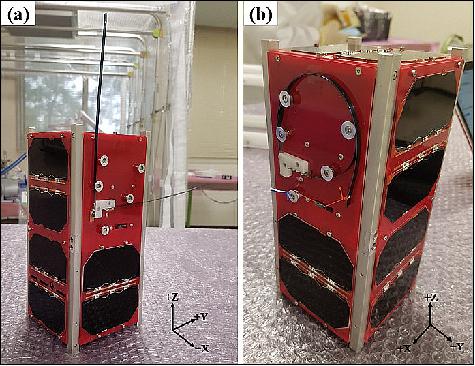
Launch
On 23 September 2018 (2:54:27 JST, or 17:52:27 UTC on 22 September), the SPATIUM-I CubeSat was launched, along with other equipment, on the Kounotori HTV-7 cargo transfer vehicle (H-IIB of Mitsubishi Heavy Industries) to the ISS. The launch site was the Tanegashima Space Center, Japan. 3)
The SPATIUM-I CubeSat was released from ISS Japanese Kibo module on 6 October 2018 at 15:45 SGT (Singapore Time, corresponding 07: 45 UTC). 4)
Mission Status
• September 23, 2021: SPATIUM-I was deorbited, reaching the end of its mission.
• In May 2019, SPATIUM-I CubeSat is functioning well since its release from ISS until now (more than 8 months). The project is collecting satellite data consistently, to evaluate the operating condition of the CubeSat. Figure 3 shows the accumulated CSAC counter data and calculated count per second since the deployment of the CubeSat. The accumulated CSAC counter counts the 10 MHz signal continuously. By dividing the data by 10 M, the operation duration (in the unit of seconds) could be determined (Ref. 1).
- As illustrated in Figure 3(b), no visible drift is observed in the count per second, indicating that the CSAC is working properly until now.
- Other satellite operational data such as the supercapacitor voltage level, the CSAC, temperature, the battery temperature and the COM temperature were also analyzed to understand the working condition of the CubeSat. It is important to understand the environment condition and battery voltage level of the CubeSat. When needed, an uplink command can be sent to change the operation duty cycle and power consumption of the CubeSat. It is observed that the supercapacitor is always in fully charged condition (~4.2 V), indicating that the solar generated power is sufficient to support the CubeSat operation. In addition, the temperature for the CSAC, battery and COM board are well-kept within a very healthy range of -10 to +40 ºC.
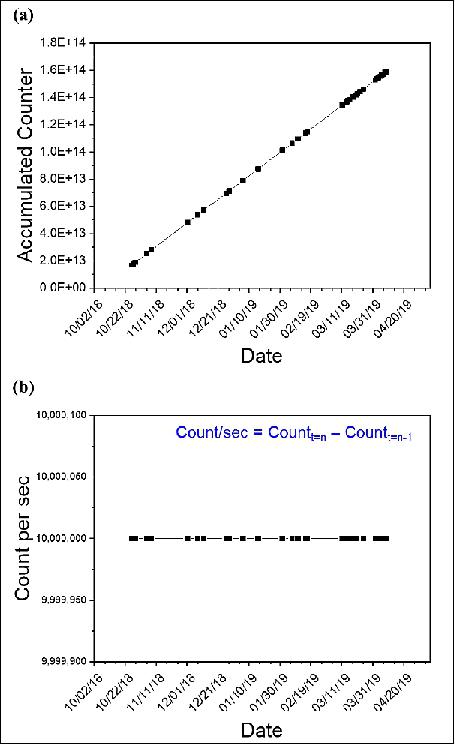
• October 7, 2018: The satellite signal was first detected at Kyutech ground station on 7 October 2018 at 20:14 SGT, one day after the satellite was released from the ISS. For the first contact, only the spread spectrum signal was captured using the spectrum analyzer. However, no signal demodulation was achieved. After some adjustments on the Doppler shift correction, the first demodulated data was successfully obtained on 17 October 2018 at 08:17 SGT. The obtained data was analyzed in detail. The accumulated CSAC counter value is 9233951493551, which is equivalent to 10 days 16 hours and 30 minutes. This duration corresponds with the total CubeSat operation period since its deployment from the ISS. From the obtained satellite data, it can be stated that the SPATIUM CubeSat is working properly as per design.
Sensor Complement
Payload CSAC (Chip-Scale Atomic Clock)
The breakthrough CSAC technology that packaged a Cesium vapor cell atomic reference oscillator in a unit several times smaller than its legacy products provided an improved SWaP (Size, Weight and Power) performance. Most importantly, CSAC provided better accuracy and stability compared to the conventional crystal oscillators such as TCXO (Temperature Controlled Crystal Oscillators) and OCXO (Oven Controlled Crystal Oscillators). Figure 4 shows the comparison of the time error, power consumption and instability of various oscillator technologies. 5)
Conventional high accuracy hydrogen maser and Cesium atomic clock are typically large size and high power consumption. The revolutionary CSAC's time accuracy, stability and power consumption performance, made it a very suitable candidate for small satellite application, where space and weight limitations did not permit traditional atomic clocks on board for accurate timing references.
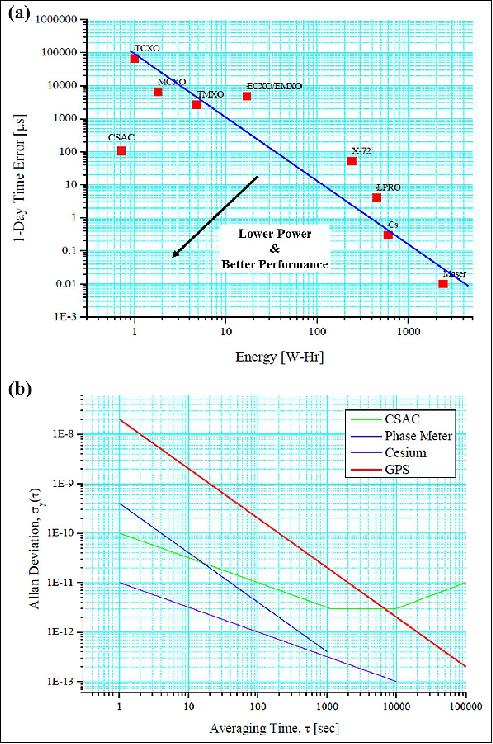
In 2011, Microsemi (previously Symmetricom Inc.) had launched the world's first commercially available CSAC, after eight years of participation in the Defense Advanced Research Projects Agency (DARPA) chip scale atomic clock (CSAC) program. The CSAC chip has extremely low power consumption of 120 mW and small volume of 16.4 cm3. The promising frequency stability performance of CSAC with short-term stability of 3 e-10 @ τ = 1 sec was essential for many satellite applications such as satellite timing and frequency control, satellite cross linking, navigation and earth observation.
For this project, the CSAC payload board was a custom-designed subsystem for the SPATIUM-I CubeSat. It had the function to output precise CSAC 10 MHz clock signal, 1 PPS (pulse per second) signal and other operation data to the communication board (COM) for data transmission to the ground station. The CSAC counter value was used for analysis of the CSAC 10MHz clock signal throughout the CubeSat mission. Under normal operation, CSAC did output very stable 10 MHz oscillation signal. Figure 5 shows the functional block diagram of the CSAC mission boards. The design was basically separated as two part: the CSAC mission board and the supercapacitor board, as illustrated in Figure 6. The CSAC mission board consisted of a CSAC chip (Microsemi SA.45s CSAC), temperature sensor, ripple counter, MCU (Micro-Controller Unit) and other electronic components required for CSAC operation.
A low noise low-dropout voltage (LDO) regulator was used to provide a stable 3.3 V voltage input to CSAC and other components on-board. A frequency counter was designed to count the 10 MHz oscillation signals from the CSAC. The counter value was to validate the clocking performance of the CSAC and to derive the phase difference in the signal transmission for TEC modelling. The counter value data together with other useful data such as a temperature sensor and supercapacitor voltage data was captured by MCU every 1 second, as triggered by the 1PPS signal from CSAC. The data was processed in MCU and sent to the communication board (COM) through UART serial data communication.
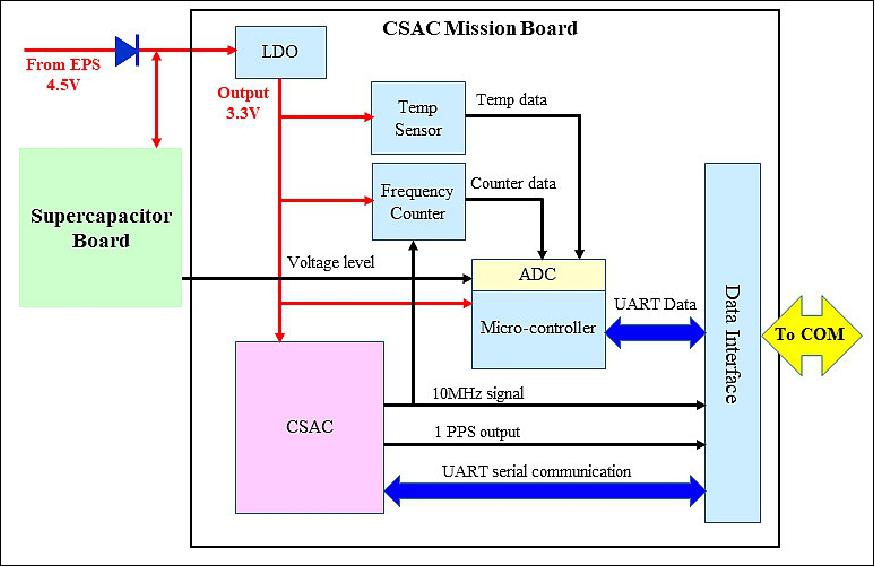
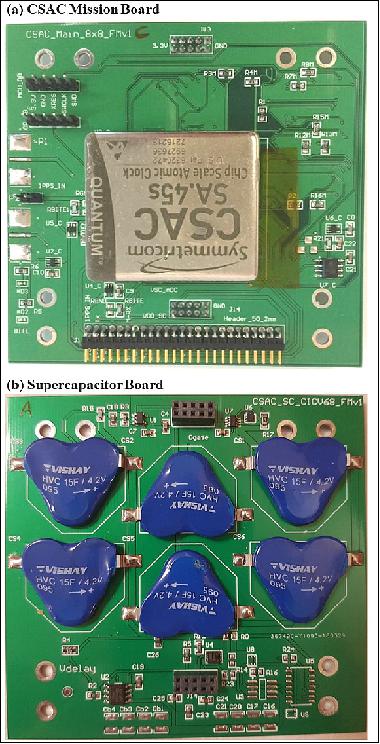
In order to avoid unwanted power disruption to the CSAC operation during the eclipse phase, a supercapacitor module was used as power back-up for CSAC board operation. This was essential to ensure that the CSAC was functioning continuously throughout the whole CubeSat mission and the CSAC was resetted due to power interruption. The detailed specification of the fabricated CSAC mission boards flight model (FM) are summarized in Table 1.
Dimension | 86.3 mm x 90 mm x 2 1 mm |
Mass | 113 g |
Voltage supply | 4.5 V |
Power consumption | 0.35 W |
Warm-up time | <180 s |
Data interface with COM | CSAC data: UART serial communication |
References
1) Chee Lap Chow, Ying Zhang, Man Siu Tse, King Ho Holden Li, Kateryna Aheieva, Rahmi Rahmatillah, Ryotaro Ninagawa, Ibukun Owulatobi Adebolu, Sangkyun Kim, Yuta Kakimoto, Takashi Yamauchi, Hirokazu Masui, Mengu Cho, "Overview of Project SPATIUM – Space Precision Atomic-clock TIming Utility Mission," Proceedings of the 33rd Annual AIAA/USU Conference on Small Satellites, August 3-8, 2019, Logan, UT, USA, paper: SSC19-WKVII-07, URL: https://digitalcommons.usu.edu/cgi/viewcontent.cgi?
article=4422&context=smallsat
2) Kiran Kumar Pradhan, BIRDS-2 members, BIRDS Partners, Faure Pauline, George Maeda, SangkyunKim, Hirokazu Masui, Mengu Cho, "BIRDS-2: Multi-Nation CubeSat Constellation Project for Learning and Capacity Building," Proceedings of the 32nd Annual AIAA/USU Conference on Small Satellites, Logan UT, USA, Aug. 4-9, 2018, paper: SSC18-WKIII-04, URL: https://pdfs.semanticscholar.org/b421/9fb7ccd73b6e46feedcefb57971198beb286.pdf
3) "Launch Results of the H-II Transfer Vehicle Kounotori-7 aboard the H-IIB Vehicle No. 7," JAXA Press Release, 23 September 2018, URL: https://global.jaxa.jp/press/2018/09/20180923_h2bf7.html
4) "Three CubeSats successfully deployed from "Kibo"," JAXA, 26 October 2018, URL: http://iss.jaxa.jp/en/kiboexp/news/1810_cubesat10_en.html
5) Robert Lutwak, "Chip Scale Atomic Clock," DARPA Microsystems Technology Symposium, San Jose, California, 5 March 2007, URL: https://apps.dtic.mil/dtic/tr/fulltext/u2/a503806.pdf
6) SatNogs DB, “SPATIUM-1 (99742)”, URL: https://db.satnogs.org/satellite/YBUM-2862-1744-3831-1621
Spacecraft Launch Mission Status Sensor Complement References Back to top